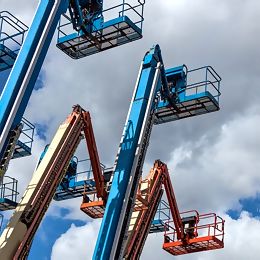
For many contractors the decision to purchase, rent or lease equipment is one that needs to be considered carefully. Each option has pros and cons, and no matter which strategy you choose for equipment acquisition, it's guaranteed to impact the bottom line.
For a long time, purchasing equipment was the only way contractors could get access to the machines they needed. Then in the early 1990s, the concept of renting heavy equipment took off within the construction industry and is now a mainstream method of equipment acquisition for contractors. Most contractors today operate using a strategy of both renting and buying to source the equipment they need, and are exploring other ways to acquire their equipment.
Costs around every corner
It’s no secret that the cost of ownership for construction equipment is steep — and equipment costs go well beyond the initial purchase price. Between loan payments, storage fees, maintenance expenses, and the cost of insurance and depreciation, owning equipment has the potential to cripple a business’s bottom line. Saving enough money to buy a piece of equipment is difficult enough, and oftentimes contractors must then grapple with the challenge of finding enough work to make the purchase worthwhile.
As a result, more fleet managers and construction professionals have turned to equipment rental companies. Renting equipment offers contractors a lower initial investment and access to the latest equipment and technology, while outsourcing responsibility for maintenance, repairs, upkeep and even transportation of equipment to and from jobsites. While renting has proven a great option for contractors who need specialized machines for once-in-a-while jobs, it can be tricky if a rental company doesn’t have the machine you’re in search of available when you need it. Also, renters must constantly be mindful of costs. If costs aren’t managed properly, the total price of renting can quickly outsize the cost of purchasing a piece of equipment.
A new model: the peer-to-peer marketplace
As contractors struggle with the decision to buy or rent their equipment, we are seeing the rise of a new model — peer-to-peer marketplaces, which allow contractors to rent equipment from other contractors.
Contractors own about three times the amount of construction equipment that rental companies do. And these peer-to-peer rental marketplaces are helping contractors tap into the supply of equipment owned by other contractors. The result is a win-win for both parties. Contractors can make additional income from renting out idle assets, while contractors looking for equipment have another means of acquisition.
These peer-to-peer marketplaces are applying the sharing economy model we’ve seen work successfully for homes (Airbnb) and cars (Uber, Lyft). In the construction sector this model is able to offer quality equipment at reduced costs. By tapping into the existing supply of contractor-owned assets, peer-to-peer exchange is creating a truer marketplace and allowing the market to dictate the value of assets, rather than abiding prices set by a handful of large entities.
Driven by data
One key driver behind the changing model of equipment ownership is the fact that more data is available to drive decisions. Telematics platforms are giving contractors unprecedented insight into their equipment — including details about utilization, as well as the overall expense associated with operating their equipment.
Before telematics, there was a disconnect between contractors and their equipment data, because there was no easy way to see all the information about your fleet all in one place. With telematics, contractors can see just how often their equipment is being used. By centralizing this data into one location, contractors can get a clear picture of their asset utilization, thereby equipping them with the necessary information to make informed decisions about whether to rent or sell those underutilized assets.
Telematics builds trust
Telematics also plays a crucial role in developing trust, a key component to the success of these peer-to-peer marketplace models. The exchange of equipment that could command tens of thousands of dollars undoubtedly creates a degree of hesitation among renters as well as owners. However, the main goal of these marketplaces is to create and support an environment of contractors helping contractors.
Renters want quality equipment that’s in working order and available when they need it, while companies or contractors lending equipment want the assurance that equipment is returned in an acceptable condition. To help satisfy such demands, these marketplaces not only vet the equipment before it’s made available to potential renters, but use telematics to track the machine and how it’s being used. Not only does this provide equipment lenders visibility into how their equipment is being treated, but renters also get the value-add of that jobsite data.
An ownership revolution
Equipment acquisition isn’t usually an easy decision for contractors. The sharing economy coupled with the rise of telematics solutions and more accessible data have created a shift in how contractors are finding and using their equipment. As contractors feel increasing pressure to keep the bottom line top-of-mind, they are turning to peer-to-peer marketplaces to better manage their fleets utilization, monetize already owned assets and rent quality equipment.